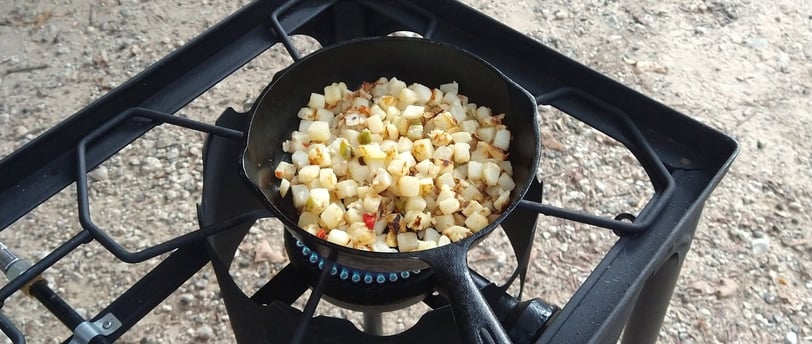Campsite Meal Planning
Comprehensive Guide to Meal Planning for Your Next Camping Trip
CAMPSITE COOKING
S. Yarborough
9/23/2023


As an Amazon associate, I earn from qualifying purchases.
Camping trips offer a unique opportunity to escape the hustle and bustle of everyday life and connect with nature. Whether you're a seasoned outdoor enthusiast or a newbie to the world of camping, proper meal planning is essential to ensure you have a satisfying and stress-free culinary experience during your adventure. In this article, we'll explore the step-by-step process of planning meals for a camping trip, from selecting the right equipment to preparing delicious and convenient campsite meals.
Step 1. Determine the Duration and Type of Camping Trip
Before you start planning your meals, it's crucial to consider the specifics of your camping trip:
- Trip Duration: Will you be camping for a weekend, a week, or even longer?
- Location: Are you camping in a remote wilderness area, a developed campground, or somewhere in between?
- Season and Weather: What's the weather forecast for your camping dates? This will affect the types of meals you can prepare.
Step 2. Take Inventory of Cooking Equipment
Your choice of cooking equipment will greatly influence your meal options. Common campsite cooking gear includes:
- Campfire: If you'll have access to a campfire, you can cook food directly over the flames or using the hot coals from the fire below and on top of a Dutch oven.
- Camp Stove: Portable camp stoves are convenient and versatile for cooking a variety of meals.
Portable Camp Stove - https://amzn.to/3resyN7
- Grill or Griddle: Portable grills, griddles, or grates can help you cook meats and vegetables with ease. You can find both here on Amazon
Grill - https://amzn.to/453LEmX
Griddle - https://amzn.to/3qQQtSr
- Cooler or Refrigerator: Ensure you have a cooler or refrigerator to keep perishable items fresh.
Coleman 5 Day Ice Chest - https://amzn.to/454atyO
- Oven or Microwave: RVs often have microwaves or ovens or both.
Step 3. Plan Your Menu
Now that you know the specifics of your camping trip and have your cooking equipment in mind, it's time to plan your menu. Consider the following factors:
- Dietary Restrictions: Consider any dietary restrictions or allergies among your camping group.
- Meals Per Day: Plan for breakfast, lunch, and dinner, as well as snacks for all in your group.
- Simplicity: Choose easy-to-prepare meals that require minimal ingredients and cookware.
- Variety: Include a mix of proteins, carbohydrates, and vegetables to keep your meals balanced and satisfying.
- Pre-Packaged vs. Homemade: Decide if you'll prepare meals from scratch or use pre-packaged camping food.
To help inspire your culinary side, these are some great camping cookbooks to consider:
The New Camp Cookbook https://amzn.to/452eJix
Weekend Camping Cookbook https://amzn.to/461Mj9t
The Campfire Cast Iron Cookbook https://amzn.to/3PO2FNx
Easy Campfire Cookbook https://amzn.to/3EMSjad
Sample Camping Menu:
Breakfast:
- Scrambled Eggs and Griddle Toast
- Coffee or tea
Lunch:
- Sandwiches or wraps with canned chicken or tuna salad
- Fresh fruit or trail mix
Dinner:
- Foil packet meals with diced potatoes, veggies, and seasoned chicken or tofu
- S'mores for dessert
Step 4. Prepare and Package Your Food
Preparation is key to a successful camping meal plan. Consider the following tips:
- Pre-chop vegetables and marinate meats at home to save time at the campsite.
- Use resealable bags or airtight containers to store pre-measured ingredients.
- Label and date all food items to ensure freshness.
- Freeze items like meat or precooked meals in advance to keep them cold longer in your cooler.
Step 5. Practice Campfire Cooking Safety
If you plan to cook over a campfire, follow these safety guidelines:
- Check campfire regulations and restrictions in your camping area.
- Use a designated fire ring or pit if available.
- Keep a bucket of water or sand nearby to extinguish the fire.
- Never leave a campfire unattended, and fully extinguish it before leaving.
Step 6. Cleanup and Leave No Trace
Properly disposing of waste and cleaning up after your meals is essential to minimize your environmental impact. Follow these Leave No Trace principles:
- Pack out all trash, food scraps, and litter.
- Use biodegradable soap for washing dishes.
- Scrape food scraps into a trash bag before washing dishes.
- Avoid washing dishes in natural water sources like rivers or lakes.
Planning meals for a camping trip may seem daunting, but with the right preparation and a bit of creativity, you can enjoy delicious and satisfying meals in the great outdoors. Remember to consider the duration and type of trip, select appropriate cooking equipment, plan a balanced menu, and practice good campfire cooking and cleanup habits. By following these steps, you'll be well-prepared to embark on a memorable and tasty camping adventure.
